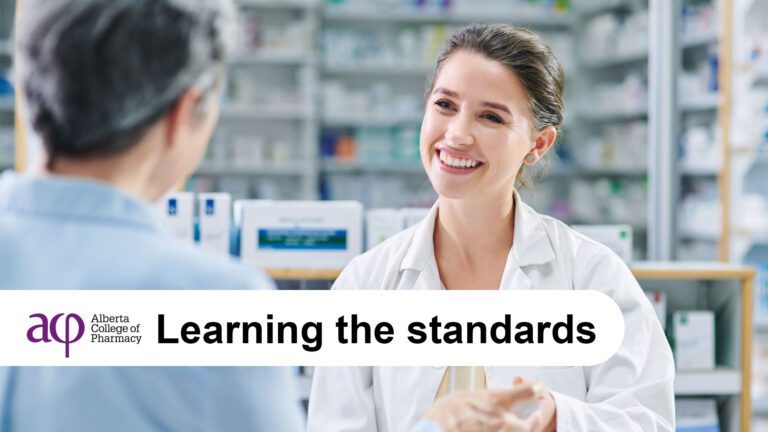According to the Canadian Centre for Addiction and Mental Health (CAMH), the term harm reduction is defined as any policy or program designed to reduce drug-related harm without requiring the cessation of drug use. Interventions may be targeted at the individual, the family, community, or society. The primary focus of harm reduction is on people who are already experiencing some harm due to their substance use.
The most appropriate interventions, whether macro or micro, are those geared to movement from more to less harm.[i] It is an evidence-based treatment approach which requires professional behaviours in caring for individuals who show signs of substance misuse when they either do not wish to enter a treatment program or when one is not accessible to them.
Abstinence from substance use may not be a realistic goal for some patients, so pharmacy professionals must acknowledge that even when individuals choose to engage in high-risk behaviours, they still require compassionate healthcare. Harm reduction dictates that we treat these individuals with respect in a non-judgmental way. Our focus as health professionals is to reduce or prevent harm to individuals; not simply focus on active treatment of a substance use disorder.
This can be a challenging concept and is more of an underlying philosophy than a specific set of actions. There is no single tool that addresses every situation. Professional judgment and person-centeredness is required when assisting every individual. To put this in perspective; consider the example of a person with diabetes who exhibits non-compliance with their prescribed treatment. Would you terminate your relationship with them, or would you work with them as best you can to support and assist them in managing their condition?
How does harm reduction fit into ACP’s opioid guidelines?
1) Pharmacists must establish and maintain a professional relationship with each individual using opioid medications. Though many patients use opioids as prescribed, some do not. It is essential to recognize the impact of social determinants of health; many of these individuals are already marginalized and/or have limited access to resources for various reasons. By not further stigmatizing them, providing non-judgmental care, and applying the principals of harm reduction, professional relationships can be strengthened. For example, using non-oppressive language helps develops trust, and furthers engagement. With time, this invites the opportunity to modify substance use trends, or even referral for treatment of a substance use disorder when the individual is ready.
2) Pharmacists must complete a thorough assessment of each individual who is prescribed opioid medications or sold an exempted codeine product. In many cases, these individuals may be on doses that exceed the maximum recommended in the 2017 Canadian Guideline for Safe and Effective Use of Opioids for Chronic Non-Cancer Pain, or have conditions that the guidelines recommend you do not provide opioids for. As always, pharmacists must use their professional judgement. Remember that it is acceptable to exceed recommended doses if it is in the best interest of the individual, if you collaborate with the prescriber, and if it is documented as a part of the treatment plan. Consider that individuals who are physically dependent on opioids who experience a sudden withdrawal of prescribed medication may be more likely to seek out illicit sources and expose themselves to even greater harm.
3) Pharmacists must document details of the assessment in the patient record of care and develop a written treatment plan for individuals using long term opioid therapy or for those determined to be at high risk of misuse or addiction. When applying harm reduction, it is critical that pharmacists regularly monitor individuals and document decisions and resulting outcomes. This process is not a one-time event; it must be continued as long as care is provided. How this is performed, and what is required, depends on the health status of every patient, every time they present. It requires pharmacists to “be in the moment” with every patient interaction they have.
4) Pharmacists must collaborate with the prescriber and other healthcare professionals involved in the care of individuals using opioid medications. Because harm reduction involves the potential for our patients to continue to engage in high risk behaviours, sometimes involving prescribed medications, it is vital that all members of the healthcare team communicate openly and collaborate when deciding the best approach to care for these individuals.
5) Pharmacists and pharmacy technicians must monitor individuals for the signs of opioid misuse, addiction, or diversion and take appropriate action. Tolerance and dependence are well-known risks of opioid therapy and can happen to any individual using these medications. Applying the principals of harm reduction means that even if the individual is not ready or willing to change their substance use behaviours, clinical issues associated with these behaviours still need to be acknowledged. Pharmacists should take all reasonable steps to ensure the individual receives the assistance and access to resources they need, which can vary depending on the individual’s unique situation.
What else can I do when an individual is unwilling or unable to stop harmful behaviour?
Harm reduction does not mean pharmacists enable or ignore behaviours such as misuse of prescribed medication or use of illicit substances. Rather, it means they confront the issues with the mindset of helping individuals in a manner that minimizes potential harm.
Pharmacists can provide harm reduction-related services such as:
- Immunizations (hepatitis A & B, Influenza, etc.);
- Ordering laboratory tests (bloodwork) when appropriate;
- Counselling on safe substance use;
- Counselling on overdose prevention and treatment, including provision and training of Take Home Naloxone;
- Referral to an opioid use disorder treatment provider or program;
- Referral to other harm reduction services such as needle exchange programs or supervised consumption sites; and
- Referral to other community agencies that can provide food, shelter, clothing and other necessities of life
More information on Harm Reduction services available in your area can be found on the Stop ODs resource page on the Alberta Health Services website.
Originally published in the November 22, 2017, issue of The Link




